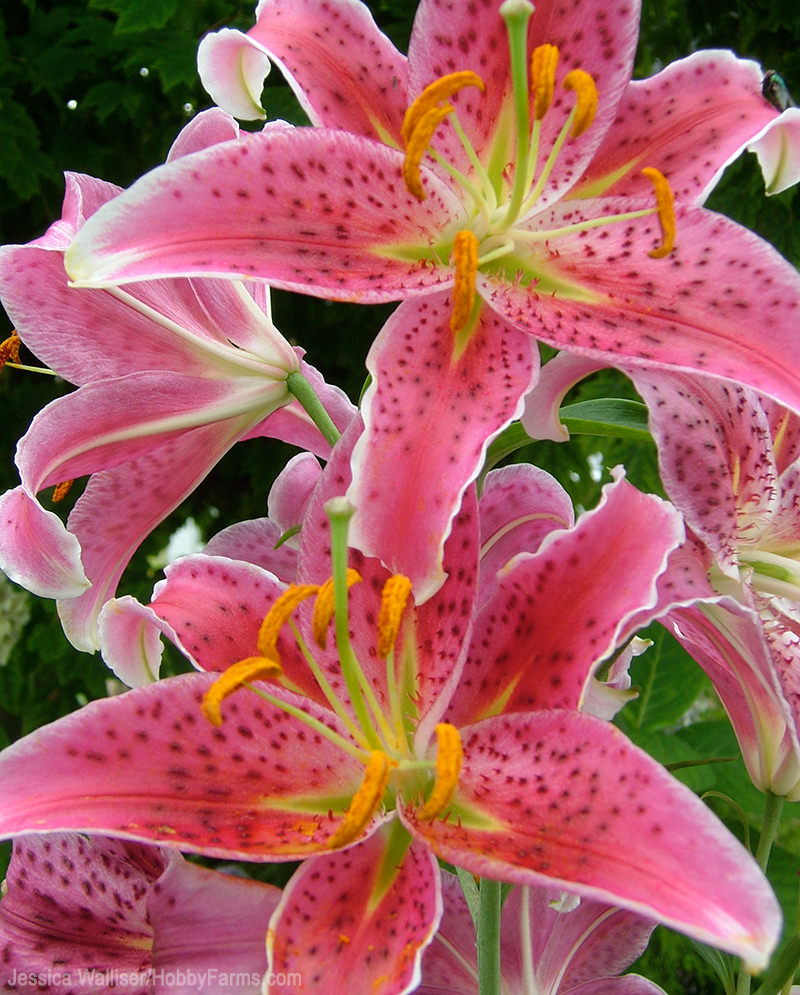

Lilies are real showstoppers in the garden, and I’m always sure to include them in my perennial beds. I’m not talking about daylilies, which while they are nice aren’t true lilies. Daylilies are in the genus Hemerocallis and grow from fleshy roots, while true lilies are in the genus Lilium and grow from bulbs.
One of my favorite things about lilies is their fragrance. Not all varieties have a heady perfume, but those that do can fragrance the air for days on end. I love having a few lilies near the patio so we can enjoy their scent in the evening.
All lilies are terrific choices for garden areas with well-drained soil and a minimum of six to eight hours of full sun each day. Lily bulbs are most often planted in the spring, and while you can purchase them as potted, flowering plants, I find the extra cost unnecessary. Buying the unsprouted bulbs is far cheaper. Not to mention the fact that when potted lilies are already in bloom, it cuts down on their in-garden bloom time. Another benefit of planting from bulbs is the plant’s ability to dedicate energy to growing a superior root system in native garden soil rather than in potting soil. This results in a root system that is better able to support the tall plant and the blooms.
Each lily bulb comprises numerous fleshy sections (called scales), and unlike a tulip or daffodil bulb, the lily bulb is not covered with the papery covering called a tunic. To plant a lily bulb, dig a 6- to 8-inch-deep hole twice as wide as the bulb itself. Nestle the bulb into the hole, spread the roots out, and cover it with soil. If you like, you can top-dress the area with an organic, bulb-specific fertilizer soon after planting.
Lilies are often separated into several different categories, a few of which are described below. Alhough this list does not include every lily available for the garden, it contains the most commonly found types.
1. Oriental Lilies

Most oriental varieties are hybrids with tall, straight stems and very fragrant, large flowers. Examples include Stargazer, all-white Casablanca and double-petaled, soft-pink Broken Heart.
2. Asiatic Lilies
Although they’re not fragrant, Asiatic selections (pictured at the top of the page) have lovely flowers often with dark speckling on the interior of the petals. They are hybrids of medium stature and many don’t require staking in the garden. Some of my favorite Asiatic varieties include the dark and mysterious Blackout and golden-orange Loreto.
3. Martagon Lilies
Tall in stature, with recurved petals and nodding flowers, Martagons are sometimes also called “Turk’s cap” lilies. They are hybrids. I’m particularly fond of Orange Marmalade and Manitoba Morning.
4. Longiflorum Hybrids
The Easter lily fits into this category. Longiflorums are often grown as nursery plants and cut flowers and don’t always make good garden specimens.
5. Trumpet Lilies (including the Aurelian types)
These are some of my favorites. With large, trumpet-shaped flowers, tall stems and an amazing fragrance, trumpet lilies are breathtaking. The flowers are slightly downturned and are especially fragrant in the evening. The brilliant-orange African Queen is my favorite of all the lilies.
6. Orienpet Lilies

A hybrid of Oriental and Trumpet lilies, these varieties have the fragrance of the Orientals, a low-maintenance temperament and grow up to 5 feet tall! Purple Prince and pink-and-yellow Satisfaction are just beautiful.
If deer are problematic in your garden, know that while no lily is deer-proof, some varieties are more resistant than others. In my own garden, I’ve had the best luck with Oriental, Trumpet and Orienpet selections. I avoid Asiatics completely as both the deer and rabbits seem to adore them. Spraying the growing lilies with repellants from the day the shoots emerge from the soil until the flowers have faded does afford them some protection.
Check your local nurseries this spring for a good bulb selection. Online sources include www.brentandbeckysbulbs.com and www.lilypadbulbs.com.
Get more ornamental-gardening help from HobbyFarms.com:
- Video: Ornamental Container Garden Design
- Grow a Colorful Cutting Garden
- 12 Pollinator-Friendly Flowers You Can Eat
- 4 Flowering Trees
- Video: How to Use a Bulb Auger
« More Dirt on Gardening »




